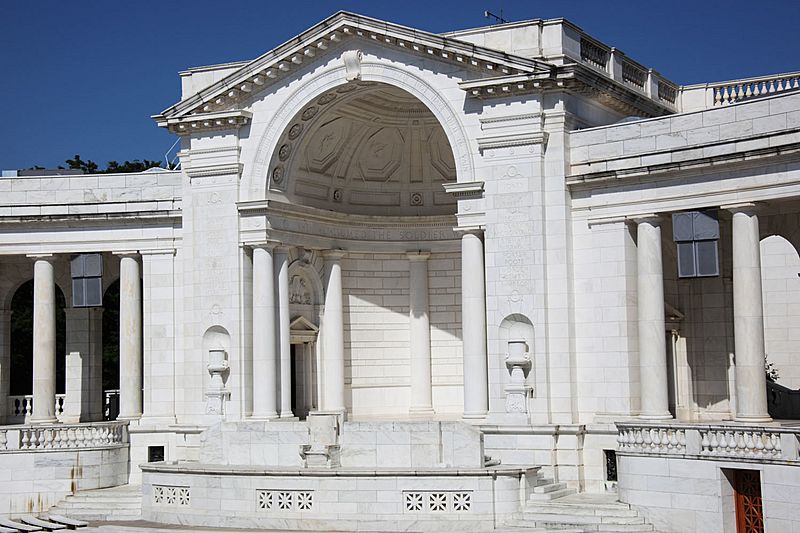Image: Apse - Memorial Amphitheater - Arlington National Cemetery - 2012-05-19

Description: Looking northeast at the klismos chair, apse, and speaker's dais from the southwest colonnade of the Memorial Amphitheater at Arlington National Cemetery in Arlington County, Virginia, in the United States. The original "Old Amphitheater" at the cemetery was constructed of wood in 1874. It was used for some of the first Memorial Day observances, but within 20 years proved too small for the large crowds using the facility. The Grand Army of the Republic, a veterans group composed of men who had served in the Union Army in the American Civil War, began pushing Congress to build a new amphitheater. Congress authorized construction of the Memorial Amphitheater on March 4, 1913. Ground-breaking occurred on March 1, 1915, and President Woodrow Wilson placed the cornerstone on October 15, 1915. It was dedicated on May 15, 1920. The architect was Thomas Hastings of the New York City firm of Carrère and Hastings. The white marble came from Danby, Vermont. Ulysses A. Ricci designed the various friezes, ornamental devices, and decorative elements of the amphitheater. The amphitheater itself sits about 5,000 people on low marble benches. It is elliptical, with an east-west depth of 200 feet and a north-south dept of 250 feet. The amphitheater is surrounded by a double-column colonnade. Above the west entrance is a quote from the Roman poet Horace: "Dulce et decorum est pro patria mori" ("It is sweet and fitting to die for one's country"). The names of battles -- from the American Revolution through the Spanish-American War -- are inscribed on the frieze above the colonnade inside the amphitheater. A raised stage occupies the east side of the amphitheater. The names of 14 U.S. Army generals and 14 U.S. Navy admirals important in American history prior to World War I are inscribed on each side of the amphitheater stage. A quote from General George Washington's June 26, 1775, letter to the Continental Congress is inscribed inside the apse: "When we assumed the soldier we did not lay aside the citizen." A quote from President Abraham Lincoln's Gettysburg Address is inscribed above the stage: "We here highly resolve that these dead shall not have died in vain." Halfway between the stage and the floor of the amphitheater is a narrow dais on which stands a carved marble throne, or klismos chair. It is designed to stay empty, a reminder of the dead heroes who cannot sit there now. A small chapel is located beneath the amphitheater stage. There is a small below-ground kitchen and a small below-ground service room on either side of the stairs leading down to the chapel. A Memorial Display Room occupies most of the ground floor of the west side of Memorial Amphitheater. It is open to the public, and contains displays about the unknown soldiers buried in the nearby Tomb of the Unknown Soldier. These displays include medals given to the unknown dead, the flags which covered them, and the history of the Tomb. Main stairs lead left and right to the second floor. On the second floor are offices and a reception room. Originally, the reception room on the upper floor was supposed to house the memorial displays, but these were moved downstairs at some point prior to the 1980s and now the upper floors are used for VIP guests. The marble of the Memorial Display Room is imported Botticino, from Italy.
Title: Apse - Memorial Amphitheater - Arlington National Cemetery - 2012-05-19
Credit: http://www.flickr.com/photos/23165290@N00/7298047340/
Author: Tim Evanson
Usage Terms: Creative Commons Attribution-Share Alike 2.0
License: CC BY-SA 2.0
License Link: http://creativecommons.org/licenses/by-sa/2.0
Attribution Required?: Yes
Image usage
The following page links to this image:

